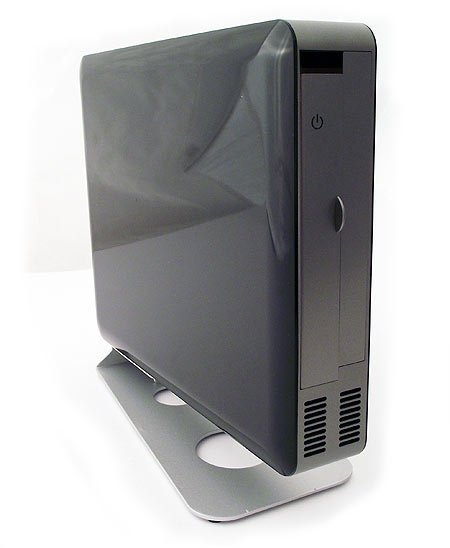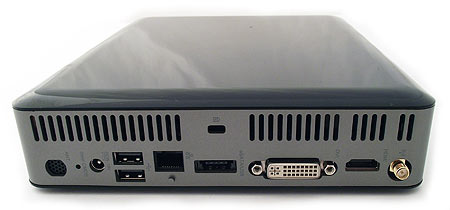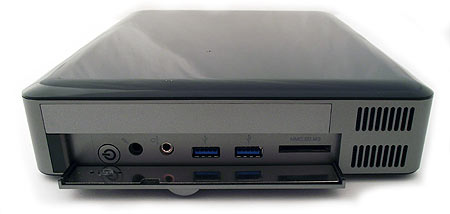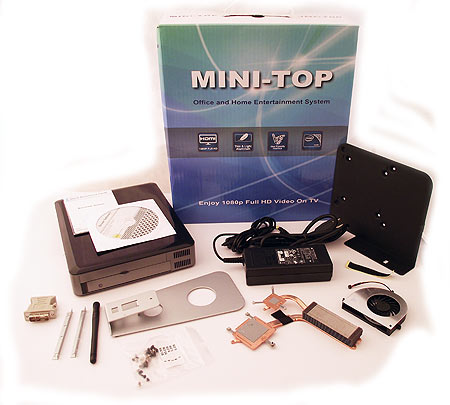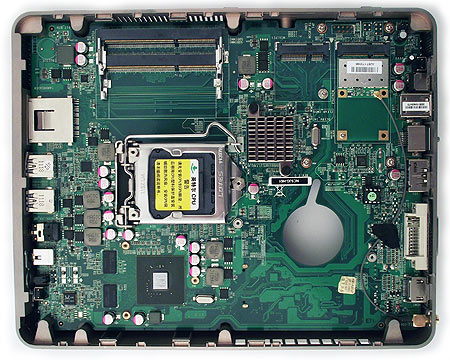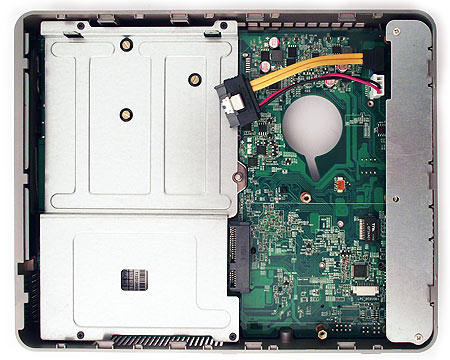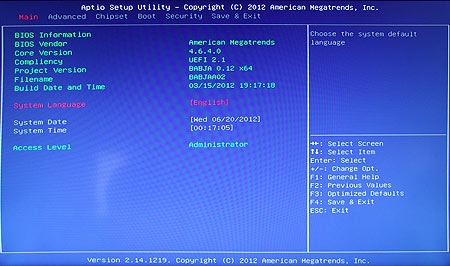Does Size Matter? Four Very Small Nettops Get Reviewed
We're comparing four diminutive PCs: ASRock’s Vision HT, Jetway’s Mini-Top JBC700, Lenovo’s Q180, and Zotac’s Zbox Nano XS AD11 Plus. Despite their similar sizes, each tiny computer offers a unique feature set. Are any of them right for you?
Jetway Mini-Top JBC700C9JG
We’ve tested Jetway’s Mini-Top family in the past; however, last time we were looking at a humble nettop powered by Intel’s D525 Atom CPU mated to Nvidia’s Ion 2 graphics chipset. The company's JBC700 shares a similar aesthetic, but offers much more capable hardware under its hood. Based on Intel's Sugar Bay platform, this is the only PC in our round-up able to accept LGA 1155 CPUs intended for the desktop (instead of mobile processors).
Be aware, though: the Mini-Top limited to 35 W low-voltage chips, and the JBC700 is only sold as a barebones platform. Its processor, drives, and memory aren't included. The JBC700C9JG we’re testing today does come equipped with an integrated GeForce GT 520M GPU and it's available from itxdepot.com for $273. There is also a version available without Nvidia’s GPU (JBC700C9J), and that sells for $180 on Newegg.com. Of course, because we have the barebones version, its final cost will be a lot higher once we fold in the prices for requisite hardware.
The GeForce GT 520M does allow Jetway's Mini-Top to use Nvidia’s Synergy technology (known as Optimus in the mobile space). This allows the system to automatically switch over to Intel's power-friendly HD Graphics engine when the performance of a discrete GPU isn’t needed. It then engages the GeForce chip when a graphics load is detected. Although that isn't as much of a benefit in the desktop space, it does let you manually choose the graphics subsystem you want to use on a per-application basis. That means specifying HD Graphics in Quick Sync-optimized apps and GeForce in games. We like the flexibility enabled there.
The Mini-Top enclosure consists of glossy plastic on the sides with brushed metal-colored plastic around the perimeter. It would be easy to miss perched on a desk, except for the odd angle it sits at on its metal mount. At 9.5” x 7.5” x 1.75”, Jetway's Mini-Top is the longest PC in our round-up, but it's not the thickest and certainly not large by any measure.
Around back we find HDMI and DVI video outputs, a Wi-Fi antenna connector, two USB 2.0 ports, an eSATA/USB combo port, gigabit Ethernet, a TV antenna connector (for the models with the optional tuner, not included in our sample), and the power supply interface.
Up front, and behind a swing-down door, there's a memory card reader, two USB 3.0 ports, the power button, an infrared remote sensor, and the commonly-found speaker output and microphone input jacks. The speaker jack also doubles as a digital S/PDIF output.
Jetway's bundle includes an external power supply, a wireless antenna, an installation guide, a driver disk, a VESA mounting bracket, a DVI-to-VGA adapter, and various internal accessories (a fan, the processor heat sink, and mounting hardware, for example).
Get Tom's Hardware's best news and in-depth reviews, straight to your inbox.
While there is no remote in the package, the JBC700 is equipped with an IR reader. So, any MCE-compatible remote should work. We tested this with a unit we had on-hand and found them to work well together, achieving 170 degrees of arc and about 14 feet of range. As a barebones system, we weren't surprised to find the Mini-Top lacking an operating system license.
The enclosure is opened without any tools by simply pushing back its side cover. The motherboard hosts a familiar LGA 1155 interface and two SO-DIMM memory slots able to accommodate 8 GB of DDR3-1333. Underneath the board, there’s room for a 2.5” drive and slimline optical drive.
Because this setup doesn't include a processor, memory, hard disk, or optical drive, we populated it with two 2 GB DDR3-1333 module and a Western Digital Scorpio Black with 500 GB of space. As for the processor, well, that gets a little complicated.
While the Mini-Top accepts LGA 1155-based CPUs, it’s only designed for 35 W Sandy Bridge models. Right now, that leaves us with a handful of T-series line-up, such as the Core i5-2390T, Core i3-2100T and -2120T, Pentium 630T and 620T, and single-core Celeron G440. We would have liked to show you this platform's best performance using a Core i5-2390T, which may have been able to match the Core i5-2120M in ASRock's machine thanks to a 2.7 GHz base clock rate. Unfortunately, T-series SKUs are often special-order models, and we weren’t able to get one in time for this piece.
Our back-up plan was to underclock and undervolt a Core i3-2100 to the -2120T's specifications, allowing it to fit within the 35 W TDP. Jetway isn't as flexible with its BIOS settings, though, and we didn't have access to the voltage and clock adjustments needed to pull that off. The system booted with the Core i3-2100 installed, but we didn't want to push the 65 W chip too hard.
Eventually, we settled on a dual-core Celeron G540 processor at 2.5 GHz. Yes, it's listed as a 65 W chip, but we've measured its consumption far lower in the past. The G540 has 1 MB less cache, doesn't support Hyper-Threading, and doesn't support Quick Sync. It also fares pretty well against the Core i3-2120T in most applications (unless they're heavily threaded), though. With no other option available, it'll have to do.
Although the Mini-Top officially supports a 666 MHz memory clock, ours defaulted to 533 MHz thanks to a limitation of the Celeron G540 despite the fact that we used modules capable of the faster setting.
Current page: Jetway Mini-Top JBC700C9JG
Prev Page ASRock Vision HT 321B Next Page Lenovo Q180 31102BUDon Woligroski was a former senior hardware editor for Tom's Hardware. He has covered a wide range of PC hardware topics, including CPUs, GPUs, system building, and emerging technologies.
-
Nintendo Maniac 64 So I'm guessing there aren't any nettops yet that use the low-voltage Trinity APUs? (17w A6-4455M and 25w A10-4655M)Reply -
daglesj Beware with the Lenovo Q180 if you buy the barebones DOS version to install Windows 7 64bit on it.Reply
The Audio doesn't work. The drivers Lenovo have up on the site are incorrect for 64bit. So far they haven't got round to changing it after 6 months.
If you buy the version with Windows 64bit installed it works. But they just wont release the right driver. -
The big problem with net tops is longevity and lack of upgrade abilities. If all you plan to do with them is surf the web,send email, chat and watch 2D video. You most likely won't care what hardware is in them. But that's not the negative about these small form factors. Its heat, and a question of how that heat will affect the hardware in such a small form? Not to mention the small PSU's and the question of why would you buy one of these over a decent well designed notebook? Even if you like the form factor and want to run Linux on one of these. Chances are Linux will challenge you on some problem with the hardware.Reply
-
daglesj For day to day office work they do the job perfectly. I know quite a few businesses that are keen to drop their old 130W desktop boxes for something easier on the power bill. I rolled out a load of Atom ION boxes about 3 years ago and all of them are still going strong in some quite challenging environments. A few of them were even overclocked to give a little extra pep and no problems yet.Reply
The main thing that holds these boxes back are the HDDs. They still keep slipping 5400rpm drives in them. You put a 120GB SSD in there and you have a near perfect general office PC. -
silverblue Looking at the D2700 vs. the 450 reminds me of days gone by with the P4D and the Athlon 64 X2. The higher clock speed plus HT of the Atom helps a lot with encoding but despite its clock speed disadvantage, the 450 easily holds its own.Reply
The next generation of both these CPU families would be worth watching out for. -
jaquith I've been debating about purchasing a MINI PC vs Building, sadly one of my HTPC's just recently took a swan dive. So do I purchase something like the ASRock Vision HT for ~$700+ ($800), Build or Repair?!Reply
The only potential drawback to these MINI PC's as an HTPC is lacking of an internal 'TV Tuner' option. However, since Cable DVR's are very common place now the 'TV Tuner' need is getting smaller every day. I have Verizon FiOS and the newer black DVR's and a HTPC to record requires a CableCARD and PCIe CableCARD e.g. Ceton InfiniTV 4 but then you run into oddball things like "Copy Once."
The Pro's & Con's are all from their size, but ~$700+ is a huge price and IMO reduces the demand. The only complete system in this article is the Lenovo Q180, the ASRock Vision HT 821B requires some form of OS and sure there's 'free' OSes but Windows 7 Home Premium OEM 64-bit will add an additional $100.
Any of these listed can be used as a simple Desktop replacement. The workaround for storage is to either purchase a large capacity 'drive' (SSD or HDD) that can 'fit' or some form of external storage including an external drive (USB or eSATA if applicable) or Windows Home Server or similar network storage device. -
chewy1963 silverblueLooking at the D2700 vs. the 450 reminds me of days gone by with the P4D and the Athlon 64 X2. The higher clock speed plus HT of the Atom helps a lot with encoding but despite its clock speed disadvantage, the 450 easily holds its own.The next generation of both these CPU families would be worth watching out for.Reply
Just about the same performance between them back in the day. Of course it's different OS's and software, but, that was from the good ole days when Athlon 64 x2 ruled the x86 performance race. -
stevelord I bought an Asus nettop last year from Walmart. And despite putting a SSD in it + 4GB of memory, it crawled at even loading web pages...especially forums. Wife noticed the speed difference and after lots of complaining sent me back to return it.Reply
-
cleeve Nintendo Maniac 64So I'm guessing there aren't any nettops yet that use the low-voltage Trinity APUs? (17w A6-4455M and 25w A10-4655M)Reply
I couldn't find any, but this article has been in the works for a while so some might have cropped up. -
cleeve jaquithThe only potential drawback to these MINI PC's as an HTPC is lacking of an internal 'TV Tuner' option.Reply
The Jetway Mini-Top in this article *does* have an internal TV tuner option. :)
